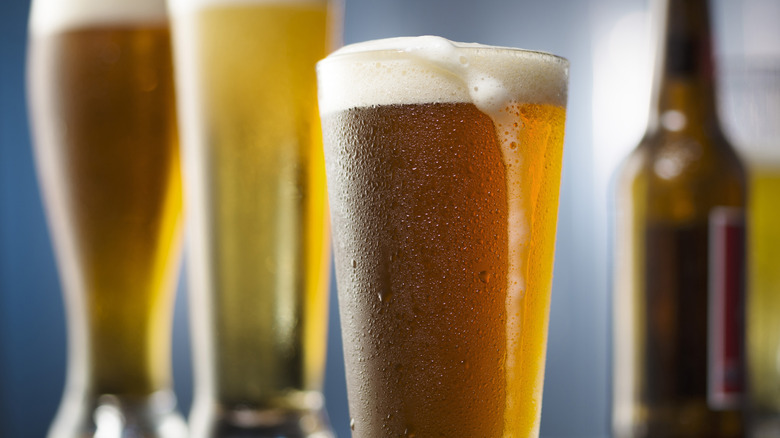This Is The Reason Beer Tastes Better Cold
Of the countless types of beer you can find at the pub or grocery store, very few, if any, are served or sold warm or even at room temperature for that matter. In fact, beer that's lost its ice-cold temperatures is deemed undrinkable by many. If you've ever wondered why beer seems to taste better when cold, we've consulted Geoff Bragg, Master Beer Judge for BJCP, for some very detailed reasons. He argues that cold temperatures favor carbonation but mask the full potential of flavors and aromas.
"From a technical standpoint, beer doesn't really taste better colder, you just taste less of it," Bragg said. "A beer that is just above freezing will lack noticeable aroma and flavor. Beer served on tap is generally kept around 38F and will warm up as you drink it. This is when the aromas and flavors will become more apparent."
Just as warming spices bloom their flavors, warming beer a mere 3 to 5 degrees Fahrenheit will bring all the suppressed tasting notes and aromas to fruition. Simply let the beer sit for a minute or two after pouring it from a cold bottle or tap so it reaches its maximum flavor potential without becoming flat.
This brings us to Bragg's second point. "Carbonation is held in solution at lower temperatures," he continued. "Ever open up a warm beer? All that CO2 is coming out of solution and into your lap. Part of the reason kegged beers are traditionally kept at 38F is to minimize foaming and therefore wasted beer at a bar."
Different temperatures for different beers
Carbonation is less of a flavor and more of a mouth feel, but it's also at the heart of the crisp, refreshing finish most of us associate with beer. So, keeping beer cold enough not only prevents a pint full of foam, but it also delivers those delightful bubbles for a satisfying finish. The carbonation will still be perceptible and effective once beers have warmed to the optimal temperature range, which experts place between 38 and 55 degrees Fahrenheit.
The reason that the range varies so much is because different beers taste better at different temperatures. Light beers with a low ABV and more subtle tasting notes like lagers, hoppy pale ales, or even Pilsners benefit from colder temperatures because they're meant to be crisp and refreshing. Plus, colder temperatures actually serve to accentuate the bittersweet flavor of ethanol while keeping the bitter hops from overpowering the subtler tasting notes.
At the warmer end of the spectrum lie the heavy beers and beers with higher ABV like porters and stouts as well as dark ales and IPAs. Since these beers have considerably more alcohol, cold temperatures will accentuate the taste of the ethanol to the detriment of the beer's complex tasting notes and aromas. If you're enjoying a flight of craft beers, this is perhaps another reason why you should start by tasting the lagers first while they're nice and cold before the darker beers.

